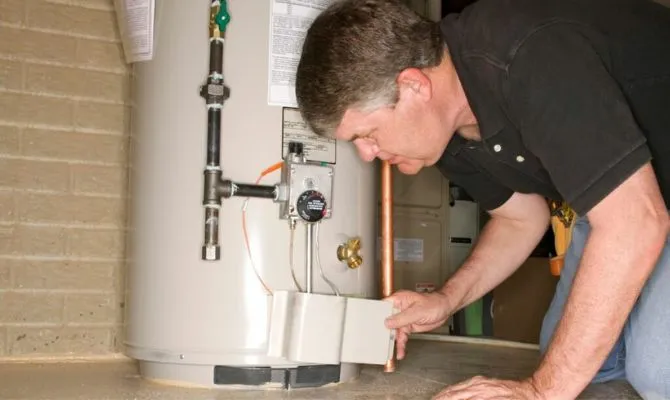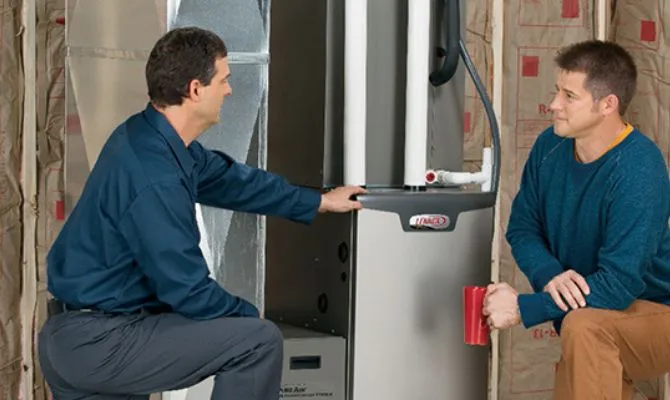A leaking water heater is a serious problem that can cause significant water damage to your home. It is important to address leaks promptly to prevent further damage and costly repairs. The experts at TEK Climate in Vancouver can help homeowners understand the reasons behind water heater leaks and determine the best course of action to fix them.
There are several potential causes of leaks in water heaters, including corrosion, faulty connections, and damaged tanks. It’s important to know the cause of the leak so you can make informed decisions about repairing or replacing the water heater.
Why is My Water Heater Leaking? What Causes It?
Water heater leaks can have serious consequences, causing damage to floors, walls, and possessions. It’s important to understand the cause of a leak so that the right course of action can be taken. Some leaks are easy to fix, while others require a new water heater. Here are the most common reasons why water heaters leak:
1. An Old Tank Can Cause Water Heater Leaking
An old tank is a common cause of water heater leaks. As a water heater ages, its parts, such as the tank and its components, start to wear out over time. This can lead to rust forming in the tank, which then causes corrosion. The corrosion creates cracks in the tank, which in turn allows water to leak through.
This can result in significant water damage to the home and its contents, making it important to address the issue quickly. If the water heater is over 15 years old, it may be near the end of its useful life, and it may be necessary to replace it entirely. Homeowners should seek the advice of a professional HVAC technician to determine the best course of action to prevent further damage and keep their home safe.
2. A Leak in the Water Heater May Be Due to a Malfunctioning Drain Valve
The drain valve is an important component of the water heater as it is used for maintenance visits, replacements, and cleaning of the tank. When the valve becomes loose, water can leak through and cause problems. This is often due to regular use and over time, the valve may no longer be able to keep a watertight seal. In such cases, a new drain valve is required to prevent further leaks.
It is advisable to seek the advice of an HVAC expert before replacing the valve, as they can diagnose the issue and ensure that the correct course of action is pursued. A homeowner may be able to replace the drain valve themselves, but professional assistance can be helpful in ensuring a proper and secure fix.
3. High Water Pressure Can Lead to Failure in the Hot Water Tank
Water heaters are designed to handle water pressure that is present in the water supply. This pressure can increase due to a number of factors, such as high water temperature or high water pressure entering the system. If the pressure inside the water heater becomes too great, it may cause leaks to occur.
This is because the excess pressure will cause water to escape through any cracks or weaknesses in the tank, in an attempt to relieve the pressure. It is important to ensure that the water temperature and pressure in the system are properly regulated, to prevent leaks from occurring due to excessive pressure.
4. Hot Water Tank Leak Because of Temperature and Pressure Relief Valve
The T&P (temperature and pressure relief) valve helps relieve pressure in the water heater tank, but when it stops working correctly, it can lead to leaks. A quick tightening of the valve may solve the issue if it’s just loose, but if the valve is damaged, you’ll need to get a new one.
It’s important to lower the pressure in the tank before attempting any repairs or replacements of the T&P valve.
5. Hot Water Tank Dripping: Inlet and Outlet Connections are Getting Loose
If your hot water tank’s inlet and outlet connections are getting loose, you may have a leak on your hands. As the connections age, they can loosen up and water may start to seep through. To fix this issue, the connections need to be tightened or replaced.
6. Internal Tank Leaking Issue
As water heaters age, the internal tank may experience leaks due to wear and tear. However, these leaks can be hard to detect as they are inside the tank and often require professional inspection to diagnose. If the water heater is old and showing signs of leaking, it may be time to consider replacement.
7. Sediment Build Up Can Cause Tank to Leak
Over time, as water is heated and then cooled repeatedly in a water heater, sediment may start to accumulate at the bottom of the tank. This sediment buildup can cause stress on the bottom of the tank and lead to cracks, eventually resulting in leaks.
To prevent this issue, it’s recommended to regularly clean out the tank to get rid of any sediment buildup. This can help to extend the life of the water heater and prevent leaks from happening due to sediment collection.
8. Hot Water Heater Leaks from Cracked Tank
A water heater with a storage tank can suffer from leaks due to cracks in its glass lining. Over time, minerals and high water temperatures can cause these cracks to form, leading to leaks in the storage tank.
Regular maintenance and cleaning of the water heater can help prevent this issue. If a cracked storage tank is the cause of the leak, the tank may need to be replaced to resolve the issue.
9. Anode Rod Causing Water Heater Leakage
An anode rod is a metal rod inside the water heater that helps to protect the tank from corrosion. Over time, the rod can corrode and become depleted, leaving the tank vulnerable to leaks. This is why it’s important to regularly inspect the anode rod and replace it as soon as it starts to become worn. By doing this, you can prevent leaks from occurring and ensure the longevity of your water heater.
Leaky Hot Water Heater: Where is it Leaking Anyway?
Water heater leaks can be tricky to pinpoint, but the location of the leak can give us a big clue about what’s causing the problem. For example, if the leak is coming from the bottom of the tank, it might be due to sediment buildup. On the other hand, if the leak is coming from a valve, it could be a sign that the valve is loose or worn out.
Knowing where the leak is coming from can help your technician diagnose the issue faster and more accurately, and it also helps homeowners be more informed about what might be going on with their water heater. So, if you’ve got a leaky water heater, pay attention to where the water is coming from and pass that info along to your technician – it could make all the difference in getting it fixed up quick!
Water Condensation vs. Water Tank Leak: Knowing the Difference
It’s important to distinguish between condensation and a real leak in your water heater, as the latter is a serious issue that requires attention from a technician. However, sometimes homeowners may confuse the two, which is why it’s good to double check before calling for help.
Condensation forms when there’s a big temperature difference between the water heater tank and the room it’s in. For instance, when the tank is hot but the room is chilly, condensation is likely to form. This is a normal occurrence and doesn’t suggest any problems with the water heater.
Water Heater Leaking from Bottom
If you’re experiencing a leak from the bottom of your water heater, it could either be a minor fix or a sign that you need a new unit. The source of the leak could be the drain valve or the tank itself. If the problem is just with the drain valve, it can usually be fixed by tightening it. However, if the tank is the cause, it will require a full replacement, which can be costly, but necessary.
Hot Water Heater Leaking from Top
If you’re seeing water leaks from the top of your water heater, there are a few potential culprits. Loose inlet and outlet connections, faulty T&P valves, and corroded anode rods are common causes. Most of the time, fixing this type of leak involves simple repairs, replacements or tighten the components.
Only in the rare case of a crack in the tank will you need to replace the entire water heater. It’s important to have the issue addressed promptly to avoid any further damage or inconvenience.
Mysterious Leaks from Hot Water Heater
If you find pools of water under the water heater, but can’t determine the source of the leak, it’s probably because the leak is happening due to too much pressure. When pressure builds up in the tank, it can find even the tiniest crack and cause water to leak out.
The problem with this type of leak is that it often stops when the pressure goes down, making it difficult to pinpoint the source unless you catch it in the act.
Leaks Inside the Hot Water Tank
Leaks in the water heater tank are tough to identify because they can’t be seen from the outside. Even though you might see water collecting at the bottom of the unit, it doesn’t necessarily mean the leak is coming from there. This is because the crack on the internal tank could be anywhere.
As the water heater gets older and the parts start to wear out, the chances of having a leak in the tank increases. Age and deterioration are the most common causes of this type of leak.
Leaking Water Heater: What Should I Do?
When your water heater tank leaks from the bottom, it can cause panic. Replacing a water heater is costly and most homeowners aren’t ready for such an expense in an emergency. However, there are steps you can take if this occurs:
Double-Check that Your Water Heater Is Actually Leaking Water
It’s important to make sure that the puddle of water you’re seeing is actually from a leak in your water heater and not from another appliance or source. To do this, you can start by wiping down your water heater and observing whether any moisture appears evenly across its surface, which could indicate condensation.
You may also want to check nearby appliances such as your HVAC system to rule out the possibility of a leak from your AC or furnace. Placing paper towels on the ground near these appliances can help you determine where the water is coming from.
Turn Off Power to Your Leaking Water Heater
When you have confirmed that your water heater is leaking, it’s essential to turn off its power source without delay. Working on an electrically powered water heater while it’s still connected to its power source can be dangerous.
For electric water heaters, locate the circuit breaker and turn off the switch dedicated to the water heater. If you have a gas-powered water heater, there is a gas shutoff valve located near the base of the tank and the gas line. Ensure that you turn it off to prevent any potential hazards.
Shutting Off the Cold Water Supply to Your Water Heater
The next step after turning off the power is to stop the flow of cold water into the water heater. There are two pipes connected to the top of the water heater tank, the cold water inlet and the warm outlet.
The cold water inlet pipe, usually indicated by blue or red coloring, provides the water tank with a supply of cold water. The warm outlet pipe transports the hot water from the water heater to your home. If the pipes are not color-coded, you can determine which one is which by feeling for temperature differences.
Most water heaters have a shutoff valve on the cold water inlet pipe. To turn off the valve, turn the wheel clockwise as far as possible if it’s a wheel-style valve. If it’s a ball valve, turn the handle 180 degrees. This will stop the flow of cold water into the water heater, minimizing water damage.
Try to Locate the Source Of Your Water Heater Leak
Now that the power and water supply have been turned off, it’s time to find the source of the leak. Start by identifying where the water is accumulating and clean it up. If the same area is wet the next day, that’s where you’ll want to begin troubleshooting.
As noted above, if the leak is at the top of the water heater, inspect the two pipes located there. The cold water inlet and warm water outlet pipes bring water into the tank to be heated and then out into your home for use. Loose fittings or connections could be the source of the leak. In this case, you can tighten the pipes with a pipe wrench.
Again, if you see water seeping down the side, it could be the Temperature and Pressure Relief Valve (T&P valve). Every water heater has a T&P valve as a safety feature to release water if pressure builds up. If the valve is leaking, check if the temperature is set too high. If it is, lower it to no more than 120 degrees Fahrenheit (as recommended by the Department of Energy). If the temperature is not too high and the valve continues to leak, it may be faulty and need to be replaced by an expert.
As noted earlier, at the bottom of the water heater, there’s a drain valve for maintenance. If you see water leaking from the bottom, check that the valve is closed. If it’s still leaking, it may be loose and need to be tightened with a pipe wrench. Be careful not to over-tighten it, as this could cause further leaks. If the valve continues to drip, you may need to replace it.
A final reminder, if there’s a pool of water near the base of the water heater tank, it could be the result of a crack in the tank. In this case, you’ll need to replace the water heater as a repair will not be enough.
Clean Up Your Water Heater Leak
It’s important to clean up any water that has leaked from your water heater promptly. Leaving the water can lead to a variety of issues, such as warping of surfaces, damage to personal belongings, and even the growth of mold and attracting insects. It’s best to address the leak and clean up the water as soon as possible.
Leaky Water Heater: Conclusion
In conclusion, if you have exhausted all troubleshooting efforts and your water heater continues to leak, it may be best to reach out to a professional HVAC technician for assistance. They have the expertise and experience to repair your water heater and restore it to proper functioning. Don’t hesitate to schedule a repair appointment with one of our HVAC pros.



